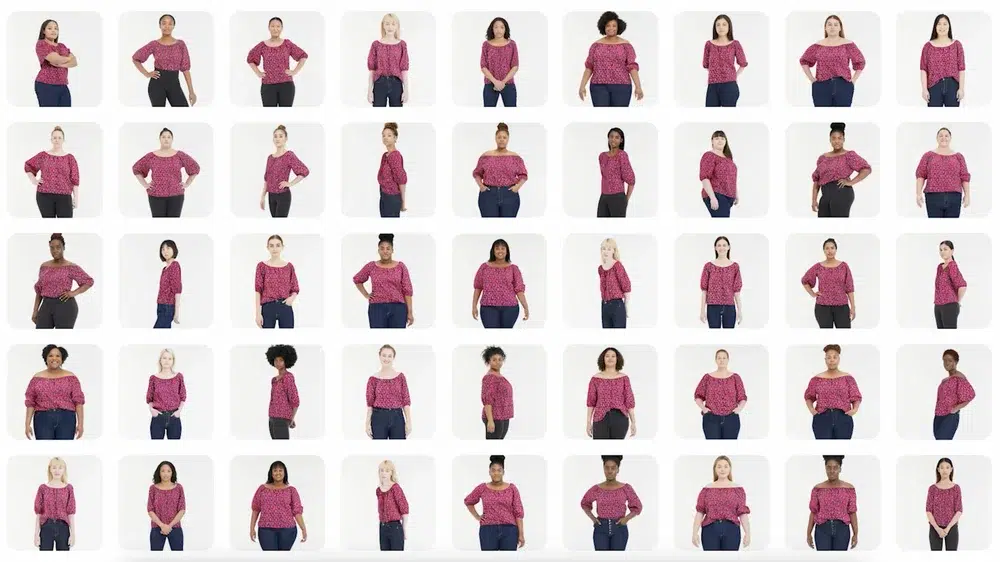Google has taken many steps over the years to advance the online shopping experience for users. From the introduction of Google Lens’ ‘search what you see’ back in 2017, to the advancement of the Shopping Graph in 2021, Google is making it ever more simple for users to have a comprehensive and engaging shopping experience, without ever having to leave the SERPs.
The launch of Google’s virtual try-on AI tool has taken this one step further, allowing users to visualise an item of apparel on a range of models with different skin tones, sizes, and body shapes, all from just one image, while offering new and advanced filtering capabilities to help narrow down the list of products.
For online shoppers, this tool is new, exciting and is certain to revolutionise the way we browse for products. But for us SEO professionals, we can’t help but wonder what the knock-on effects will be for eCommerce website performance, and what we need to do to adapt to this.
We’ve unpacked everything you need to know about virtual try-on (VTO) and what it means for SEO, as well as our recommendations on what you can do to optimise your product listings so that your site doesn’t suffer the consequences.
What is virtual try-on, and how does it work?
Google’s virtual try-on feature aims to bring the experience of in-store shopping (or something akin to it) to the digital landscape. The AI tool can “take just one clothing image and accurately reflect how it would drape, fold, cling, stretch and form wrinkles and shadows on a diverse set of real models in various poses”.

The tool utilises a generative AI model, combining image-based diffusion and a cross-attention process to produce the desired image output.
In a nutshell, this works by:
- Sending an image of the clothing item to a unique neural network that holds latent variables capable of learning the structure of the image
- Gradually adding noise, AKA pixels, to the image until it becomes unrecognisable
- Stripping back this noise until the image can be reconstructed in perfect quality, enabling the model to learn the concept abstraction (representation of high-level features) behind the image and therefore create variations of it
When more than one image is used, each is sent to its own neural network. A cross-attention process is then used to share information between the two, enabling an output based on both images.
In the case of virtual try on, the two images used are 1) the apparel and 2) the person, which produces an output of a photorealistic image of the person wearing the garment.

In addition to this VTO feature, the tool also comes with a new filtering process. It uses visual matching algorithms to refine inputs including style, pattern and colour, allowing users to navigate multiple brands at once when shopping online.
This means that users can explore products from a multitude of retailers, all within the comfort of the SERPs. The user would only need to navigate through to the product detail page (PDP) when they are ready to complete the purchase.
Is VTO available everywhere?
In short, no. VTO is currently only available for U.S. shoppers via Google’s Shopping Graph, and only for select brands such as H&M, Anthropologie and Everlane. The filtering capabilities are also only available for U.S. shoppers and can currently be found within product listings for tops.
However, as the tool gets more precise, the technology will scale and therefore expand to more brands and locales. So even if VTO hasn’t made it to Europe and the wider EMEA region yet, it doesn’t mean we can ignore it.


What does VTO mean for SEO & eCommerce website performance?
The stand-out eCommerce knock-on from the launch of VTO is the increasing likelihood that a user will not need to leave the SERPs to fulfil their shopping experience.
Users will be able to explore product listings from multiple brands at once, utilising filters and try-on features, all without having to navigate through to a retail website. This will mean we’ll likely see an increase in zero-click searches from commercial and transactional intent keyword queries, and a drop in traffic to product listing pages (PLPs) and PDPs.
Keyword performance will be harder to measure, as without crucial click-through data it will be more difficult to understand how users are responding to a SERP listing. Click-through rates (CTR) may drop, and subsequent conversions may suffer too.
In addition to this, we’ll lose valuable insights into customer behaviour and their journey through the conversion funnel, from awareness, right through to interest, conversion and re-engagement. This will be due to these interactions taking place in the SERPs instead of on the website.
Image SEO and data markup will be more important than ever in order to maintain a presence within the Shopping Graph and optimise for the new refinement capabilities, and those who aren’t utilising these strategies may very quickly suffer the consequences.
The good news is that the launch of VTO doesn’t necessarily mean a loss in revenue when it comes to eCommerce sales. Providing your PDPs are optimised with both text-based and visual content, and you’ve maintained an edge over your competitors when it comes to your offering, your product listings can maintain visibility and encourage those all-important clicks through to conversion.
You may even see an increase in organic conversion rate as a result of this new tool. This is because users who click through to your product listings, having already refined their selection and viewed your product on their chosen model, will be more likely to convert than a user who is still in the earlier stage of their shopping journey.
So, what can we do to optimise for VTO?
1. Ensure you have a comprehensive image SEO strategy in place
Image SEO is often neglected in favour of text-based SEO. However, ensuring images are optimised will be a crucial factor when it comes to eligibility for VTO and the new filtering capabilities.
Your strategy should focus on:
- Image size and quality
- Images should be kept small enough to ensure faster loading, but without compromising on quality.
- Compress images where applicable to reduce file size whilst maintaining integrity.
- Ensure the right file type is utilised for the image. JPEGs are often a good choice for photographs, whilst PNGs are ideal for images with transparency or simple graphics.
- Use exact dimensions rather than scaling up or down using CSS or HTML.
- Relevancy and placement
- Images should be relevant to the PDP and useful to both the search engine and the user. A poorly chosen image can be detrimental to user experience.
- Ensure that images are embedded within the appropriate context and relevant content. Google places importance on the relevance of images to the surrounding text.
- Alt text and filenames
- While it’s unclear exactly how Google’s new refinement process will work, having well optimised filenames and Alt text is a fundamental element of image SEO, and will no doubt play a big role in determining how Google categorises your image or product within the Shopping Graph.
- Alt text should be descriptive and utilise keywords to satisfy queries and provide content to search engines.
- Filenames should also use keywords, and should be short and concise for optimal readability.
- Image sitemaps
- Your eCommerce site is likely to have a large number of images, and therefore could benefit from creating an image sitemap and submitting it in Google Search Console. This will help search engines to discover and crawl your images more efficiently.
2. Ensure PDPs are properly marked up with structured data
We all know (or should know) the SEO benefits of utilising structured data, from higher CTRs, richer SERP listings and voice search optimisation to improved discoverability and faster indexing. The benefits of this with Google’s Shopping Graph and VTO will be no exception.
Product pages should be effectively marked up with relevant structured data in order to improve ranking positions and user experience within the SERPs.
We recommend the following attributes:
- Product Name: The name of the product being displayed on the page
- Product Description: A brief and accurate description of the product
- Product Image: The URL of the image representing the product
- Product Brand: The brand or manufacturer of the product
- Product Availability: Indicate whether the product is currently in stock or out of stock
- Product Price: The price of the product, specified in the appropriate currency format
- Currency: The currency used to specify the product price
- Product Condition: Specify whether the product is new, used, or refurbished
- Product Rating and Reviews: Include the product’s rating and the total number of reviews it has received
- Product Aggregate Rating: If available, provide the overall rating for the product based on customer reviews
- Product Offers: If the product has any special offers or discounts, you can include them in this section
- Product Variants: If the product comes in different variations (e.g., colours, sizes), you can list them here
- Product Seller Information: Provide details about the seller or store offering the product
- Shipping Details: Include information about shipping options, costs, and delivery times
Structured data can be implemented using JSON-LD, microdata, or RDFa formats. Google’s preferred format is JSON-LD, as it allows you to add the structured data directly to the page’s HTML without modifying the existing content.
Remember to test your structured data using the Schema Validation Tool or Google’s Rich Results Test to ensure it has been correctly implemented and is recognised by search engines.
3. Optimise the on-page and technical content on your PDPs
While image SEO and data markup will be key when it comes to VTO optimisation, that doesn’t mean you should neglect the on-page text content on your PDPs. All the standard optimisations still apply and should be accounted for, including:
- Optimised meta titles and H1s – focused on satisfying the most important keyword queries.
- Well-written, keyword rich meta descriptions including compelling language and call to actions.
- Persuasive and informative product descriptions, incorporating keywords whilst maintaining readability to really sell the product to the customer and appeal to search engines.
- Effective internal linking strategies to cross-link between relevant products and category pages.
- Customer reviews and ratings to help satisfy Google’s E-E-A-T guidelines and encourage conversions.
- Breadcrumbs on the page, especially for sites that utilise faceted navigation which may help to inform which filters Google can apply to your PDP within the shopping graph.
- Correct implementation of canonical tags and ensuring pages are not blocked by no index tags or robots.txt.
- Ensuring that all relevant PDPs are listed in the website sitemap for faster discoverability and subsequent indexing.
Don’t forget to ensure you have an effective out-of-stock product management strategy in place too, in order to maximise revenue potential from products listed within the Shopping Graph.
A final word
Virtual try-on is a new and exciting tool which is sure to transform the way we shop online. While the feature is not available in Europe at the time of writing (summer 2023), all SEOs need to be aware of this, and should should start ensuring now that PDPs are relevant, high-quality and well optimised, so that when the rollout does happen, your products are best placed in the SERPs to ensure that you don’t fall behind the competition.



